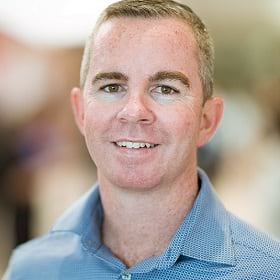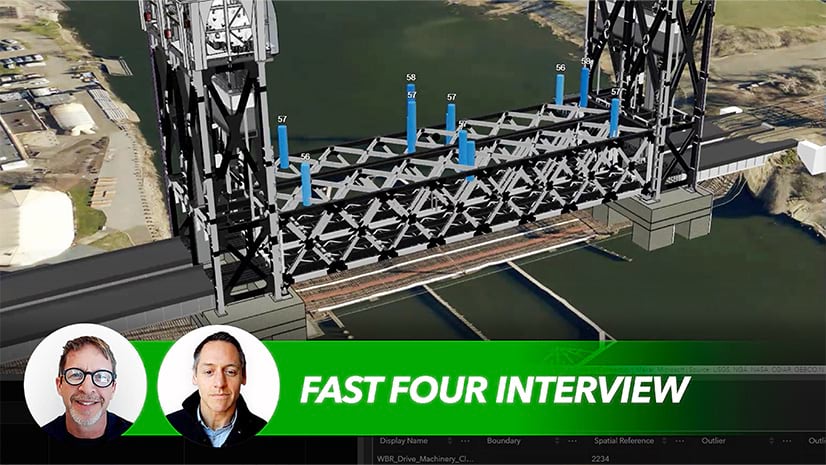Across the United States, hammers are ringing, cement trucks are churning, and cranes are rising: a historic building boom is underway.
The architecture, engineering, and construction (AEC) industry is riding a wave of billions in federal spending on infrastructure, a swell of momentum to expand renewable energy facilities, and a revitalization of the auto industry and transportation sector. According to the Census Bureau, construction spending in manufacturing last year was the highest on record.
At the forefront of this once-in-a-generation upgrade are firms like HDR that have the expertise and scale—11,000 employees—to tackle complex infrastructure projects and the technological savvy to deliver them efficiently.
A unit that’s seldom in the spotlight but increasingly central to HDR’s approach is its Geospatial and Information Management (GeoIM) team. This 130-person, multidisciplinary unit develops maps and dashboards that guide projects for AEC clients while monitoring the social and environmental impacts of America’s latest major build-out.
From Supporting Role to Enterprise-Wide Resource
Run by director Bridget Brown, HDR’s GeoIM department uses geographic information system (GIS) technology to provide location intelligence across the full project life cycle, including design, environmental permitting, regulatory compliance, construction, and strategic communication.
In recent years, GIS has evolved from playing a supporting role at HDR to being a core enterprise system. It’s become a data management tool for ambitious projects like the Ontario Line, a rapid transit line spanning nearly 10 miles and 15 stops in downtown Toronto. GIS was the central hub for more than a thousand professionals across multiple teams and organizations to share data and access 3D visualizations of the new subway line.
Location is the common denominator of every physical asset, from a bridge column to a transmission tower, and GIS software brings context to that data, giving all project participants a single source of truth. Through the technology, HDR project leaders and senior management gain real-time operational awareness of projects that often span state lines and disciplines.

[GIS] allows you to make a project area come to life in a way that's easy to host a virtual meeting, to just screen-share in the map space. It's a great way to focus people's attention and quickly turn on data layers as they come up in conversation. You can immediately show them the data and their spatial relationships and respond. It's a powerful facilitation tool.
Data Collection: 24 Hours vs. Three Weeks
One HDR project is a power line stretching 500 miles from Wyoming to Utah. Over 500 people working on the effort use maps generated by the GeoIM team, which interlace dozens of datasets on everything from the project’s geographic boundaries to which environmentally sensitive areas contractors must avoid.
Construction and maintenance teams feed data into the maps in real time, influencing the decisions of project leaders. Thanks to location technology, data collection, analysis, and communication efforts which once took three weeks can now be turned around in 24 hours.
“It would be impossible to do this at the speed that is wanted by our clients without these kinds of tools,” says Brown, GeoIM’s leader and a 15-year HDR veteran who began as a GIS technician.
That accuracy and accessibility moves projects to completion on schedule. It also satisfies customer interest in digital delivery and integration with software programs like BIM and CAD, which combine with GIS to produce 3D models and digital twins.
Developing an Equity Atlas
As today’s building boom intensifies, planners and builders are mindful of mistakes of the past. Companies like HDR are using the power of data analysis tools, including GIS, to go beyond regulatory requirements for equity and environmental justice.
Those efforts are channeled through HDR’s Community Analytics group—a partnership between members of GeoIM and the strategic communications team. This internal joint venture leverages location intelligence to help project leaders and clients understand the needs of communities affected by projects and communicate with those stakeholders
Brown has been instrumental in helping to grow the Community Analytics program, connecting members with resources and training, and creating opportunities for them to present their work to colleagues and at conferences.
For each project, the Community Analytics team conducts a human geography study, gathering demographic, environmental, economic, and psychographic data about a project area into what they call an Equity Atlas. With GIS, they add locally relevant information, like metrics on internet connectivity, transportation access, floodplain analysis, or historical patterns of racial bias like redlining.
The geographic context helps leaders better understand communities impacted by new projects and gain their trust. As the program has matured, the insights gained from spatial analysis have influenced not just communications strategies, but even how engineering and construction teams approach building.
“Our goal is to embed equity and inclusivity as a fundamental part of all our infrastructure design and our planning processes,” says Vanessa Bauman, the data solutions communications lead at HDR.
Since the Community Analytics practice began in 2018, its members have worked on 191 projects, including stormwater management plans and carbon reduction tools.
“Our clients are asking for it,” Brown says. “It’s a growing and super important aspect of our program and how we’re using spatial data to make decisions in that arena.”

It used to be it was a figure in the PDF or a report, and now it's, "Hey, I'm bringing up this map in this meeting with the client PM and the stakeholder." We go to this map in every meeting to help make decisions and see progress.
A Leader with an Eye for Location-Smart Solutions
Brown didn’t immediately gravitate to location technology. In fact, she tried to avoid classes in GIS while studying wildlife ecology in college, preferring to focus on research and writing. But after she joined the US Forest Service, an assignment to study the impacts of helicopter travel on goats near Girdwood, Alaska opened her eyes to the power of location analysis.
A GIS-based app tracked the movements of aircraft and animals, integrating real-time information with spreadsheet data. “I loved it,” Brown says of the project. “I was just replicating what we were seeing in the real world in this digital way.”
Initially, Brown didn’t envision herself as a manager—until a mentor encouraged her to apply for an open GIS manager position. In the years since she won the role, she’s helped provide direction to GeoIM and watched the team double in size. Her experience in the Alaskan backwoods inspired a calm, open leadership style.
“People that have spent time in that kind of wilderness, they understand how to sit back,” says Frank Pisani, a senior GIS manager at HDR based in Pennsylvania. “I think she has maybe drawn on that experience and that kind of solitude to really help craft how she can listen and kind of keep focused and keep the ears open to what the needs are.”
Appointed director of GeoIM in 2022, Brown encourages her team to collaborate across departments and ensure that project leaders have the tools they need. She also supports around 2,000 non-GIS specialists—HDR biologists, transportation planners, bridge engineers—who use location technology in their daily work.
Brown has fostered the development of GIS tracking tools to demonstrate GeoIM’s impact on HDR’s bottom line. And she has answered calls from senior business leaders, who increasingly look to location technology to study markets and analyze where project opportunities are emerging.
Digital technologies like GIS help AEC firms take full advantage of today’s epochal building boom. At HDR, GeoIM has been a quiet but powerful force guiding decision-making at the leadership level while accounting for real-life impacts of infrastructure on communities and the environment.
The Esri Brief
Trending insights from WhereNext and other leading publicationsTrending articles

December 5, 2024 |

November 12, 2018 |

July 25, 2023 |

February 1, 2022 |

July 29, 2025 |

August 5, 2025 | Multiple Authors |






